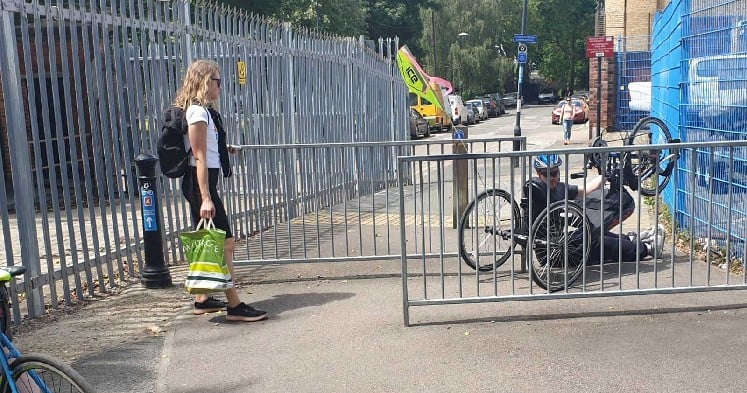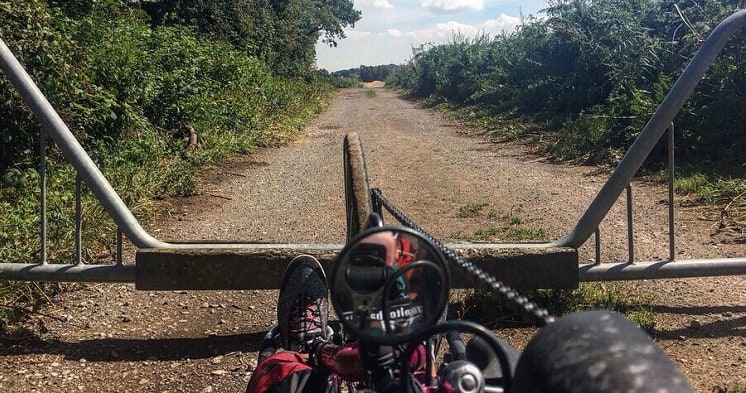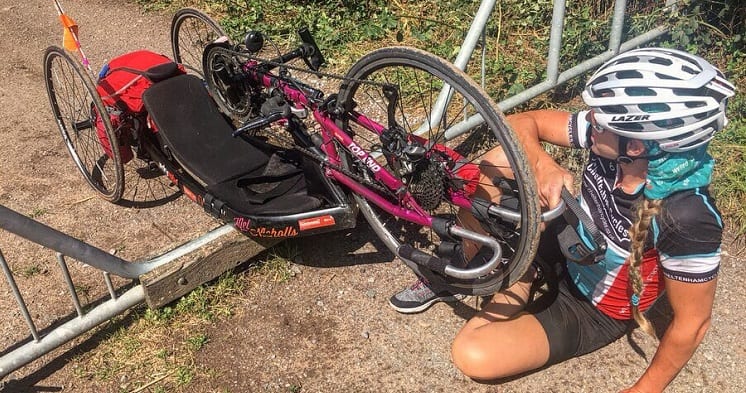Route planning apps and GPS make cycling to new places so easy. You’re at A, you want to go to B; you put it into the app, then follow the route. Assuming that there are no mishaps (punctures, low battery, losing the GPS connection), you’ll arrive at your destination. If it says there’s cycle access, you’ll find it on the ground. You don’t expect to find a wall blocking off a road, or that a residential street has suddenly become the M1 if it’s not on the map.

Photo credit: Rick Rodgers
However, for Disabled cyclists, it’s not that easy. Cycle routes often include narrow cycle lanes, tight chicanes, steps, kissing gates, K-frames, or closely-spaced bollards that aren’t wide enough for a cycle other than a standard two-wheeled bicycle to pass through, or rely on the cyclist dismounting and wheeling their cycle. If you ride something wider/longer/heavier than a bicycle, and/or can’t easily dismount and wheel your cycle, you’re (literally) stuck. You could look for an alternative route, but that might risk riding in heavier traffic. You could give up and go home, but that’s exceptionally frustrating at best, and not an option if you have to get somewhere. Worse still, you might be on too narrow a path to safely do a U-turn….
This is where route planners and maps don’t work for Disabled cyclists. They don’t mark barriers, steps, or narrow cycle lanes, and there isn’t an ‘accessibility filter’ like there is on some public transport apps. If you’re cycling somewhere new, there’s no way of guaranteeing which route will be the route you can actually use. In our survey last year, 51% of Disabled cyclists reported being unable to complete their journey due to inaccessible infrastructure.

Photo credit: Mel Nicholls
Not being able to be reasonably certain of completing a journey is stressful. It stops you from being able to reach a destination, creates tiring and time-consuming detours, pushes you into dangerous traffic, or makes it harder to go on group rides with non-Disabled bicycle riders. It makes it hard to enjoy exploring new places, or simply using your cycle as a means of getting around. It’s another unwanted reminder that society forgets Disabled people and their diverse needs, leading to many journeys being unnecessarily made by motor vehicle.
We fight for a world in which cycle infrastructure is fully accessible; where it doesn’t matter whether you are Disabled, or whether your cycle has 2 or 3 wheels. We want a world in which all have equal rights to travel actively and to experience the benefits of cycling.
And in the meantime, maps of cycle networks and route planning apps need to show where different barriers currently exist, allowing Disabled cyclists (or anyone on a non-standard cycle) to plot a route that suited their needs. The technology is available, but no one’s made it into a user-friendly app (yet!).

Photo credit: Mel Nicholls
If you’re a Disabled cyclist, a cargo-cyclist, a tricyclist, or just a bicyclist who wants everyone to be able to cycle on any type of cycle, if you see a gate, tight chicane, steps, close-spaced bollards, or any other barrier on a cycle lane, tell your council or local authority to remove it. Submit a Freedom of Information request to find out who is responsible for the barrier and whether an Equality Impact Assessment was conducted first. Help us (and the rest of the Beyond The Bicycle Coalition) #BashTheBarriers, so that everyone can get to where they need to go – however they cycle.
